Update
General Notes on Updating:
Update the only if:
- you need new functions that are not yet supported by your version,
- the new version fixes bugs that affect your system
- your DHD vendor or DHD recommend an update.
Normally, a working system does not have to be updated.
When updating, follow the steps:
- Connect the core to ethernet
- Update the kernel, if necessary
- Update the firmware, if necessary
- Connect Hardware to the core
- Load your config
Warning
Do not disconnect your core or computer from the ethernet while an update is uploading!
When experiencing any problems during upload, do not restart the core and upload the update again.
Firmware
Every device is equipped with the most up-to-date firmware at the time of delivery. Because the software is developed constantly, after a certain time, a newer version might be available than the one in your system. Ask your DHD vendor for the current state of the firmware for your device.
If a newer version is available, you first have to consider whether an update makes sense to you.
Tip
Update the firmware only if
- you need new functions that are not yet supported by your version,
- the new version fixes bugs that affect your system or
- your DHD vendor or DHD recommend an update.
Normally, the firmware of a working system does not have to be updated.
If you want to update the firmware, first find out the firmware version on your system.
Tip
You can find out the current firmware version on your system on the Main Window - Firmware Page of the selected device.
A firmware update is supplied as a file. Firmware updates of DHD devices are e.g. titled as follows:
XS-XC-XD_08-01-06.fw8 for all 52/XS, 52/XC, 52/XD cores
XS2-XC2-XD2_08-01-06.fw8 for all 52/XS2, 52/XC2, 52/XD2 cores
The shortcut XS-XC-XD_08 or XS2-XC2-XD2_08 describes the firmware version of the device and the type of firmware for different device types. The second number (here: 01) relates to the major version of the firmware. The third number reflects the minor version of the firmware (here: 06).
When updating the firmware a fourth number is visible. This always must be 01 and indicates that this is an official version. This number is not shown explicitly in the file name. Every firmware file has the file extension .fw8.
1. In the Update menu select Update Firmware and open the update file. The validity is tested and you are asked to confirm and start the update or cancel the procedure if necessary.

2. The update starts after you click Yes. The process is indicated by a progress bar and can take some time.
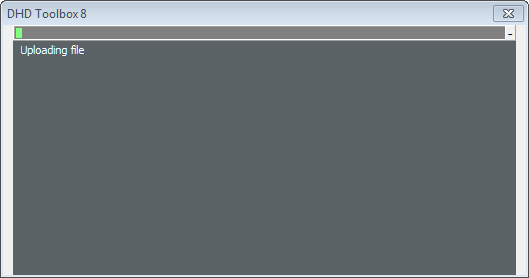
Warning
Do not disconnect your core or computer from the Ethernet while an update is uploading!
When experiencing any problems during upload, do not restart the core and upload the update again.
3. After the successful update, you are asked to restart the system. The new firmware is accepted by the system only after this system reboot.
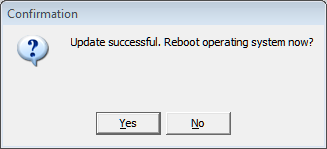
Important
A system reboot temporarily interrupts the audio processing of the system. Reboot only if you are sure that it does not influence important signals.
You can postpone the system reboot, but keep in mind that the system runs on the old firmware version until the reboot is made.
Update Kernel
Every device is equipped with the most up-to-date kernel at the time of delivery. Because the software is developed constantly, after a certain time, a newer version might be available than the one in your system. Ask your DHD vendor for the current state of the kernel for your device.
If a new version is available, you first have to consider whether an update makes sense to you.
Tip
Update the kernel only if
- you need new functions that are not yet supported by your version,
- the new version fixes bugs that affect your system or
- your DHD vendor or DHD recommend an update.
Normally, the kernel of a working system does not have to be updated.
If you want to update a kernel, first find out the kernel version on your system.
Tip
You can find out the current kernel version on your system on the Main Window - Operation System State of the selected device.
A kernel update is supplied as a file. Kernel updates for a DHD device are named according to the following scheme:
imxkernel-V1_0_15.img
The shortcut imxkernel-V1 describes the official kernel version for the device. The second number (here 0) names the major version of the kernel. The third number corresponds with the minor version of the kernel (here 15). The fourth number must always be 00, because it indicates that this is the official version. The number is not explicitly quoted in the file name. Every kernel file of the device has the extension .img.
1. In the Update menu select Update Kernel and open the update file. The validity is tested and you are asked to confirm and start the update or cancel the procedure if necessary.
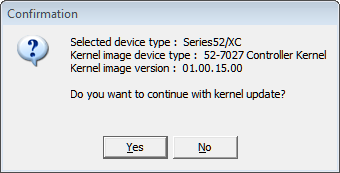
2. The update starts after you click Yes. The process is indicated by a progress bar and can take some time.
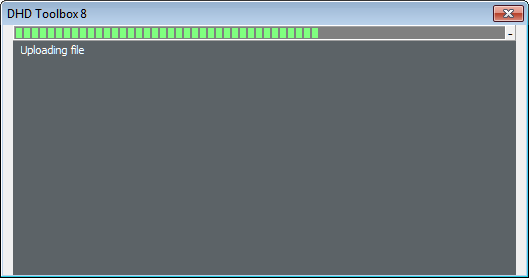
Warning
Do not disconnect your core or computer from the ethernet while an update is uploading!
When experiencing any problems during upload, do not restart the core and upload the update again.
3. After the successful update, you are asked to restart the system. The new kernel is accepted by the system only after this restart.
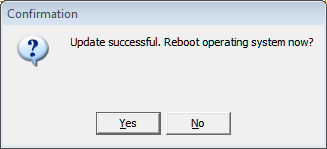
Important
A reboot temporarily interrupts the audio processing of the system. Reboot the system only if you are sure that it does not influence important signals.
You can postpone the system reboot, but keep in mind that the system runs on the old kernel version until the reboot is made.